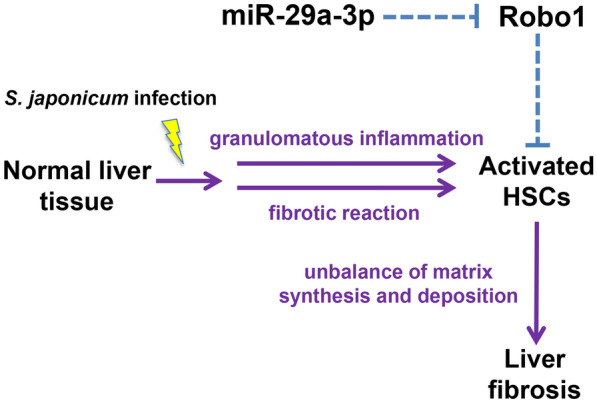- Record: found
- Abstract: found
- Article: found
MicroRNA-29a-3p prevents Schistosoma japonicum-induced liver fibrosis by targeting Roundabout homolog 1 in hepatic stellate cells

Read this article at
Abstract
Background
Schistosomiasis is a serious but neglected parasitic disease in humans that may lead to liver fibrosis and death. Activated hepatic stellate cells (HSCs) are the principal effectors that promote the accumulation of extracellular matrix (ECM) proteins during hepatic fibrosis. Aberrant microRNA-29 expression is involved in the development of fibrotic diseases. However, less is known about the role of miR-29 in Schistosoma japonicum ( S. japonicum)-induced hepatic fibrosis.
Methods
The levels of microRNA-29a-3p (miR-29a-3p) and Roundabout homolog 1 (Robo1) were examined in liver tissues during S. japonicum infection. The possible involvement of the miR-29a-3p-Robo1 signaling pathway was determined. We used MIR29A conditional knock-in mice and mice injected with an miR-29a-3p agomir to investigate the role of miR-29a-3p in schistosomiasis-induced hepatic fibrosis. The functional contributions of miR-29a-3p-Robo1 signaling in liver fibrosis and HSC activation were investigated using primary mouse HSCs and the human HSC cell line LX-2.
Results
MiR-29a-3p was downregulated in humans and mice with schistosome-induced fibrosis, and Robo1 was upregulated in liver tissues. The miR-29a-3p targeted Robo1 and negatively regulated its expression. Additionally, the expression level of miR-29a-3p in schistosomiasis patients was highly correlated with the portal vein and spleen thickness diameter, which represent the severity of fibrosis. Furthermore, we demonstrated that efficient and sustained elevation of miR-29a-3p reversed schistosome-induced hepatic fibrosis. Notably, we showed that miR-29a-3p targeted Robo1 in HSCs to prevent the activation of HSCs during infection.
Conclusions
Our results provide experimental and clinical evidence that the miR-29a-3p-Robo1 signaling pathway in HSCs plays an important role in the development of hepatic fibrosis. Therefore, our study highlights the potential of miR-29a-3p as a therapeutic intervention for schistosomiasis and other fibrotic diseases.
Related collections
Most cited references53
- Record: found
- Abstract: found
- Article: not found
MicroRNAs: genomics, biogenesis, mechanism, and function.
- Record: found
- Abstract: found
- Article: not found
MicroRNAs: target recognition and regulatory functions.
- Record: found
- Abstract: found
- Article: not found
